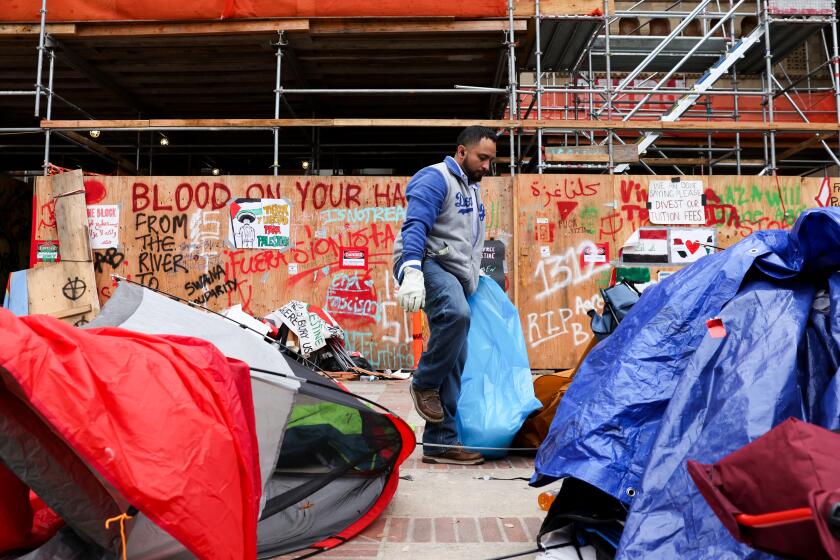Shasta Dam Protectors Look Back With Pride
One of the first thoughts that popped into Doug Latimer’s head Sept. 11 was whether he could find someone to take a couple thousand hot dogs off his hands.
That morning was supposed to be Shasta County’s annual county employees’ picnic. Latimer, as chief administrator, was set to be host. But the picnic was quickly canceled, and the hot dogs were sent to a local charity.
Then the reality of the attacks on the World Trade Center and Pentagon settled over him and Latimer began worrying about a much more serious problem: Shasta Dam. A terror attack could never happen here, he thought. Or could it?
Holding back a reservoir of 4.5 million acre-feet of water just up the road from this old lumber town of 80,000, Shasta Dam is one of the three largest in the nation. Experts say its 15 million tons of concrete would be next to impossible to breach. But if someone did manage to take it out, the flood would cover an area the size of Connecticut. Half the people around here could be killed and the state water system seriously damaged.
On that day, the possibility seemed real enough that Latimer took on a strategic role in the nation’s new war on terrorism. So did the 76-member Shasta County Sheriff’s Department and every police agency--big and small--in the county.
On orders of the Interior Department, Shasta Dam was immediately closed to the public and 24-hour guards were posted, most of them pulled in from local police agencies.
In dozens of other rural and urban communities all over California, local officials scrambled to keep things calm, looking to help in any and every way.
Within days, most communities tapped into state and regional emergency systems that already existed, simply modifying them for the new terrorist threat. But on that first day, all those people were mostly on their own. And as the first anniversary of that day approaches, most of them look back with pride.
“Shasta County is a good example of a rural area that has strategic value and had to be guarded,” said George Vinson, a career FBI agent with a background in counterterrorism who was brought in after Sept. 11 by Gov. Gray Davis to help run state anti-terror efforts.
“Terrorists, in general, are strategic thinkers,” Vinson said. “You shut them down in one area, they will pop up in another. While our major population centers are obvious targets, there are plenty of places like Shasta County where both law enforcement and the public need to stay alert.”
The population of Shasta County is about 170,000. It’s mostly pine trees and lakes and farms. Doug Latimer describes it as “sort of like a Midwestern town in the Bible Belt,” with Redding as the county seat.
Economic Cornerstone
Shasta Lake and Shasta Dam are key to California’s Central Valley Project. More than 600 feet high and almost 900 feet thick at its base, the dam is a cornerstone of California’s farm economy and the most important component in the state water system, supplying 20 million people.
“If somebody could breach that dam, there would be massive flooding all the way down to Sacramento, 160 miles from here,” Latimer said. “So we were worrying about that and also the possibility somebody could poison the lake.”
In the entire nation, only Grand Coulee Dam in Washington state and Hoover Dam compare. Grand Coulee is wider and Hoover is taller. The water Shasta Dam captures from the Sacramento, Pit and McCloud rivers helps produce two-thirds of the nation’s food supply.
The last thing Lt. Dave Dean of the Shasta County Sheriff’s Department ever figured was that he might have to protect it from foreign attackers.
“I didn’t have a concern that they would blow Shasta because it is so enormous. But the public did,” Dean said.
So off he went, along with half the law enforcement agents in Shasta County, to take turns guarding the dam.
Top Tourist Attraction
Shasta Dam also is the biggest tourist attraction in Shasta County, next to the lake itself. It draws about 40,000 visitors a year for guided tours. There were some angry visitors at first, especially one who got arrested on a drug charge after being stopped for a terrorist check.
But gradually things settled down. Pinkerton guards now patrol the bridge instead of sheriff’s deputies and local police. While groups are no longer allowed to roam the dam at will or tour its bowels, small groups who give 72 hours’ notice are allowed for brief visits.
While security rules for visitors are beginning to ease, Dean said, officials are preparing a permanent ban on operation of boats within 1,000 yards of the dam. And law enforcement remains more alert.
The same scares that frightened big city dwellers scared residents of Redding too. There were a few anthrax hoaxes to worry about. And some domestic terrorist groups believed to be in the area are still drawing special state law enforcement attention.
Dean looks back at those early days as a good teaming of rural and urban forces. As elsewhere, the precautions at Shasta Dam involved federal, state, county and city agencies working closely together. “It’s taught us all a lot, I think,” he said. “Our top priority here is still natural disasters. We had a fire in 1999 that destroyed 274 houses. And while we’ve been keeping our eye on the lake for terrorists, the real danger is from drunks. We have had five deaths on the lake so far this year.
“The way I look at 9/11 is that it was a shock that it occurred, but it shouldn’t have been a surprise,” he said.
In addition to continued security concerns about the dam, Shasta County’s other primary post-Sept. 11 goals in the coming year include improving public health capabilities.
Disaster Plans Refined
In Northern California, Shasta County is the regional hub of a nine-county area with mutual aid emergency medical plans for major disasters. Since Sept. 11, officials said, those plans have been refined significantly.
One of the region’s major needs, local health officials said, is an improved laboratory to provide more sophisticated medical testing. Shasta County Public Health Director Marta McKenzie and Dr. Andrew Deckert, the county’s health officer, are seeking $2.5 million in state money to improve the county’s lab. Other goals, McKenzie said, include improving communications with private physicians, law enforcement agencies and the public.
Meanwhile, Doug Latimer is back to thinking about hot dogs.
Shasta County’s 1,900 county employees never did get their picnic last year. But Latimer has one scheduled this year, for Sept. 17.
There will be daylong observances of Sept. 11 in Redding and other Shasta County towns, just as there will be across the nation.
And he expects a peaceful day.
More to Read
Start your day right
Sign up for Essential California for news, features and recommendations from the L.A. Times and beyond in your inbox six days a week.
You may occasionally receive promotional content from the Los Angeles Times.






